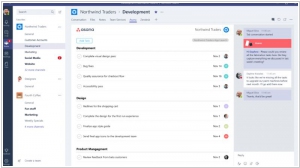Airtable vs Asana
March 19, 2025 | Author: Michael Stromann
21★
Part spreadsheet, part database, and entirely flexible, teams use Airtable to organize their work, their way.
49★
Asana is the shared task list for your team, where you can plan, organize & stay in sync on everything.As fast as a text editor. Plenty of keyboard shortcuts, fewer page loads and mouse clicks. Asana is one app that won't get in your way.
In a distant corner of the digital galaxy, Airtable and Asana are two very different beasts that somehow manage to share a few surprising traits. Both are cloud-based, which means they exist somewhere far above our heads, in the land of Wi-Fi and instant updates. They work tirelessly to help teams and individuals manage projects and tasks, providing real-time notifications as though the universe itself is reminding you not to forget that email. Their apps are as mobile as a highly organized hitchhiker, always ready to keep track of your tasks wherever you go.
Now, if you're looking for something a little more like a giant, data-stuffed filing cabinet in the sky, Airtable might be your best bet. Launched in 2012 in the US, it operates like a highly customizable database where grids, Kanbans and calendars can be as easily manipulated as the strings of a well-strummed guitar. Perfect for those who find joy in organizing the chaos of creative projects or perhaps cataloging the contents of an imaginary warehouse, Airtable caters to the detail-oriented and database-obsessed with a flair for flexibility.
Meanwhile, Asana, which has been gracing the internet since 2008 (also from the good ol' US of A), focuses on the art of task management for teams who need to stay productive without risking their sanity. Asana is where your to-do list becomes a project timeline with Gantt charts that look as impressive as a 42-step guide to intergalactic travel. It’s the perfect tool for teams that like to assign tasks, set due dates and track every dependency—especially if you’re trying to optimize workflow without accidentally opening a portal to another dimension.
See also: Top 10 Low-Code Platforms
Now, if you're looking for something a little more like a giant, data-stuffed filing cabinet in the sky, Airtable might be your best bet. Launched in 2012 in the US, it operates like a highly customizable database where grids, Kanbans and calendars can be as easily manipulated as the strings of a well-strummed guitar. Perfect for those who find joy in organizing the chaos of creative projects or perhaps cataloging the contents of an imaginary warehouse, Airtable caters to the detail-oriented and database-obsessed with a flair for flexibility.
Meanwhile, Asana, which has been gracing the internet since 2008 (also from the good ol' US of A), focuses on the art of task management for teams who need to stay productive without risking their sanity. Asana is where your to-do list becomes a project timeline with Gantt charts that look as impressive as a 42-step guide to intergalactic travel. It’s the perfect tool for teams that like to assign tasks, set due dates and track every dependency—especially if you’re trying to optimize workflow without accidentally opening a portal to another dimension.
See also: Top 10 Low-Code Platforms





